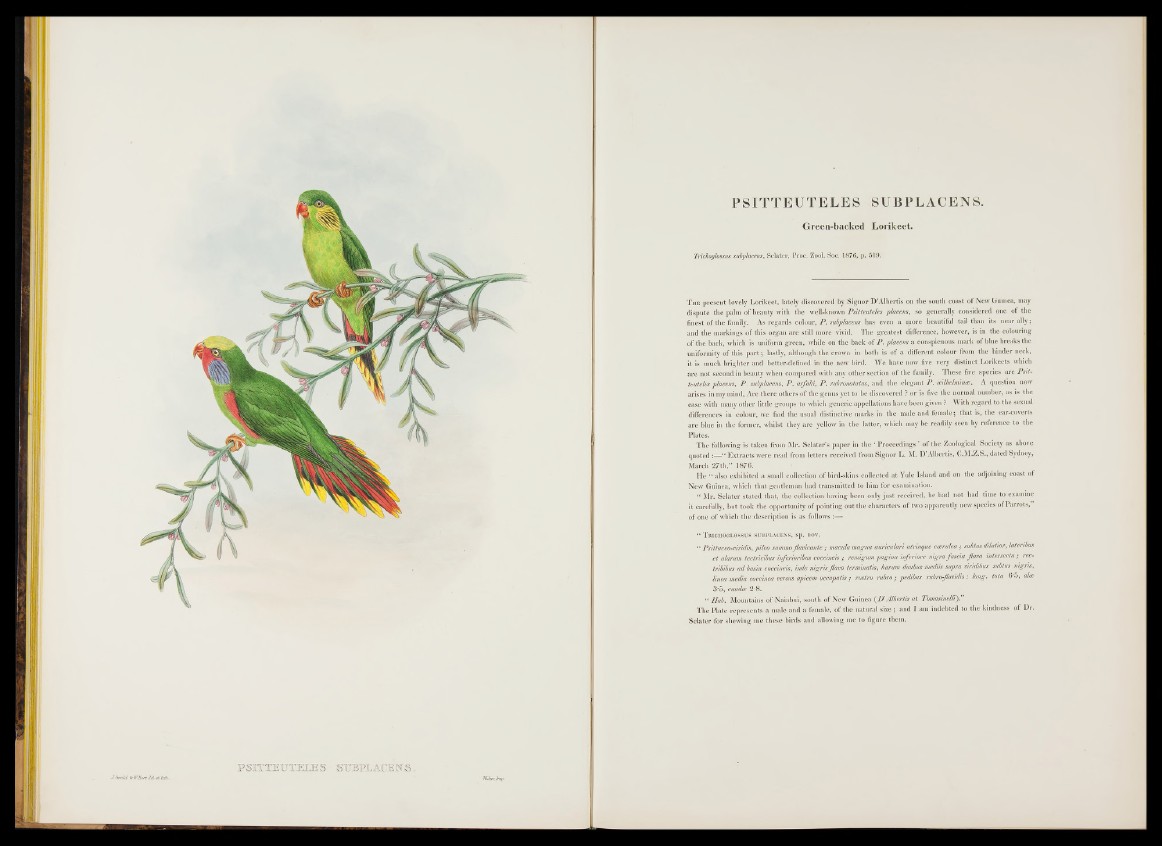
3? SH IE U T E L E S SDBELACENS
PSITTEUTELES SUBPLACENS.
Green-backed Lorikeet.
Trichoglossus subplacens, Sclater, Proc. Zool. Soc. 1876, p. 519.
T h e present lovely Lorikeet, lately discovered by Signor D’Albertis on the south coast o f New Guinea, may
dispute the palm of beauty with the well-known Psitteuteles placens, so generally considered one o f the
finest o f the family. As regards colour, P . subplacens has even a more beautiful tail than its near ally ;
and the markings o f this organ are still more vivid. The greatest difference, however, is in the colouring
o f the back, which is uniform green, while on the back o f P . placens a conspicuous mark of blue breaks the
uniformity o f this p a r t ; lastly, although the crown in both is o f a different colour from the hinder neck,
it is much brighter and better-defined in the new bird. We have now five very distinct Lorikeets which
a re not second in beauty when compared with any other section o f the family. These five species are Psitteuteles
placens, P . subplacens, P . arfaki, P . rubronotatus, and the elegant P . wilhelminee. A question now
arises in my mind, A re there others o f the genus y et to be discovered ? or is five the normal number, as is the
case with mauy other little groups to which generic appellations have been given ? With regard to the sexual
differences in colour, we find the usual distinctive marks in the male and female; that is, the ear-coverts
a re blue in the former, whilst they a re yellow in the latter, which may be readily seen by reference to the
Plates.
The following is taken from Mr. Sclater’s paper in the ‘ Proceedings ’ o f the Zoological Society as above
quoted Ex tracts were read from letters received from Signor L. M. D’Albertis, C.M.Z.S., dated Sydney,
March 2 7 th ,” 1876.
He “ also exhibited a small collection o f bird-skins collected at Yule Island and on the adjoining coast of
New Guinea, which th at gentleman had transmitted to him for examination.
“ Mr. Sclater stated that, the collection having been only ju s t received, he had not had time to examine
it carefully, but took the opportunity o f pointing out the characters o f two apparently new species of Parrots,
of one o f which the description is as follows :—
“ T richoglossus subplacens, sp. nov.
“ Psittaceo-viridis, pileo summo flameante ; macula magna auriculari atrinque ceerulea ; sub tus dilutior, lateribus
e t alarum tectricibus inferioribus coccineis ; remigum pagina inferiore nigra fascia flaca intersecta; rec-
tribibus ad basin coccineis, inde nigris flavo terminatis, harum duabus mediis supra viridibus subtus nigris,
linea media coccínea versus apicem occupatis ; rostro rubro ; pedibus rubroflavidis: long, tota 6’5, alee
3*5, caudee 2'8 .
“ Hab. Mountains of Naiabui, south o f New Guinea (jyA lb e rtis e t Tomasinelli).
The P late represents a male and a female, of the natural size ; and I am indebted to the kindness o f Dr.
Sclater for shewing me these birds and allowing me to figure them.